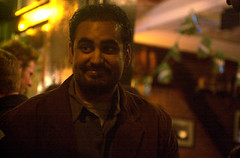Light bent on itself?!
 According to a report by Scientific America, researchers have developed a method of refracting light back on itself in the opposite direction than how it wants to natural bounce off a surface.
According to a report by Scientific America, researchers have developed a method of refracting light back on itself in the opposite direction than how it wants to natural bounce off a surface.What's this mean, it's means there's some crazy stuff going on with the study of light and adjusant to that is the way we see.
The obvious application for this would be a cloaking devices for military applications, but I'm not interested in that.
I wonder what, if anything, this means for photography?
Another area of research involved the ability of certain materials to amplify light to make even the faintest of objects come in more clearly.
Given enough research and development this could mean greater ISO sensitivity and sharper images, and if adapted properly it could mean more accurate replication of film ISO, because in everything I have seen digital ISO and film ISO are not 1:1 equivalents and as great as high ISOs appear from a Mark II, it's never quite looked like the film counterparts that I learned with.
It could also mean better performance in low light situations. It's all very experimental and as of now the research is not aimed at photography, although I am sure it will be used in astronomy very soon.
Light fascinates me, so maybe I'm stretching to relate it to photography (why did I call this blog 'SLR'.. oh right, I thought it was clever), but this is some interesting research. Maybe we'll get some sort of new film stock out of this that will let us capture the world in new ways.
Even infrared was first developed as a scientific tool, and look at where that went. (Which reminds me, is solarizing a print a lost art?)
Labels: film, funstuff, news, personal, photo, science, tech








<< Home